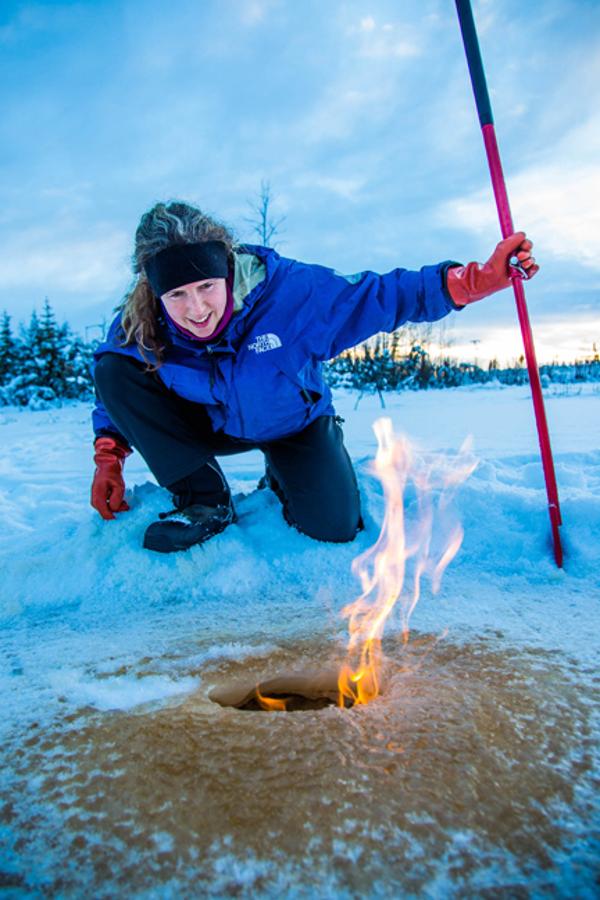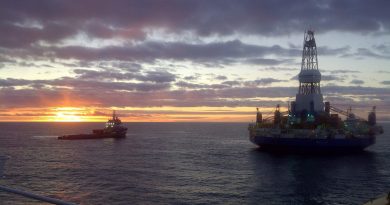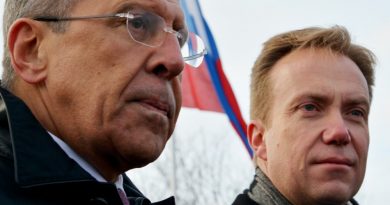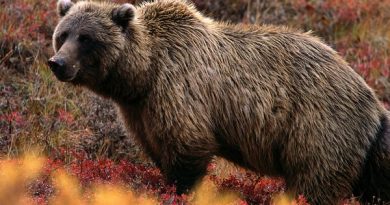Scientists calculate methane loads bubbling up from Arctic lakebeds
For the past 15 years, Katey Walter Anthony has been chasing the bubbles of methane that rise up from Arctic lakes.
The methane, which is concentrated enough to be set ablaze, is released from lakebeds as carbon-loaded permafrost thaws and, as a greenhouse gas, triggers even more warming.
“It’s the strongest sign that we see of the carbon-feedback loop,” said Walter Anthony, who estimates she has visited 200 Arctic lakes.

Now the University of Alaska Fairbanks scientist and her colleagues have captured some of those bubbles and used them to produce the first calculation of how much methane has flowed into the atmosphere from thawed Arctic lakebeds.
Measuring past emissions
Over the past 60 years, 100 million to 300 million metric tons of methane have streamed up from once-frozen lakebeds in the Arctic, concludes a study by Walter Anthony, who is with UAF’s International Arctic Research Center, and her colleagues. The study was published in London-based Nature Geoscience, part of the Nature group of journals.
“This is the first time we’ve put it together on a landscape scale,” Walter Anthony said.
Radiocarbon dating shows that the methane rising to the top of lakes is ancient, matching the carbon that — until the permafrost thawed — was sequestered in the frozen soil for thousands of years, dating as far back as the Pleistocene epoch, which ended about 12,000 years ago. Permafrost contains old plant and animal material.
The lakes’ total emissions of carbon, including that in carbon dioxide, appears to be much more difficult to pin down; Walter Anthony’s study pegs it at 200 million to 2.5 billion metric tons.
Future emissions could double
Levels of carbon released from Arctic lakebeds have risen steadily over the past six decades, but there have been no methane explosions from the newly thawed lakebeds, Walter Anthony and her partners found.
Even bigger increases are expected in the future.
Climate models predict that permafrost lakes’ cumulative carbon emissions over the remainder of the 21st century could be more than double the emissions produced from such lakes between the end of the last Ice Age and now, according to the study.
To better predict future emissions, scientists need to know what happened in the past, Walter Anthony said.
To reach their conclusions, the scientists sampled methane and soil at 37 lakes in Alaska, Russia, Sweden and Canada. They captured bubbles of methane rising up from the lakes — the bubbles were 80 percent methane — and took gas samples to the laboratory, where they isolated carbon from the samples. What was left was pure graphite that could be dated using the radiocarbon method, Walter Anthony said.
“It’s like a little piece of pencil lead in your hand,” she said.
They also examined historical data about lakes and their changes, using aerial photos and other information. Water bodies atop permafrost are known as thermokarst lakes; they expand or contract as thaw causes the ground to cave in, fill with water or drain.
The lake areas with the most methane bubbles are at the margins, places where water has expanded and thaws what was previously dry and frozen land, Walter Anthony said.
‘A carbon sink’
Because lakes vary in their responses to permafrost thaw and in the type of permafrost they overlie, their levels of methane emissions also vary, she said. Some of the biggest methane producers, she said, have been in Interior Alaska and parts of Siberia, in places where yedoma — a particularly ice-rich type of permafrost — predominates.
Arctic-wide, dry land is expected to produce more carbon from permafrost thaw than lakes. Dry land, which comprises much more Arctic territory, is also emitting carbon from thawing permafrost. But that is dominated by new carbon — the byproduct of expanding plants that expel carbon in the soil through their spreading roots.
Emissions of that modern carbon are expected to rise sharply through the end of the century, but the above-soil spread of Arctic vegetation might keep pace and cancel out those emissions.
A recent report from the U.S. Geological Survey predicts that Alaska’s ecosystems, which currently absorb 3.7 million metric tons of atmospheric carbon annually, will continue to be a “carbon sink” through the end of the 21st century. The USGS report predicts expansion of carbon-dioxide-absorbing Arctic plants in Alaska will offset carbon emissions from thawing permafrost.
Related stories from around the North:
Canada: Canadian river carries carbon from thawing permafrost to sea, Alaska Dispatch News
Finland: Climate change brings new insect arrivals to Finland, Yle News
Greenland: Can we still avert irreversible ice sheet melt?, Deutsche Welle’s Ice-Blog
Norway: UN Secretary-General to visit Norwegian Arctic, Eye on the Arctic
Russia: Ancient virus found in Arctic permafrost, Alaska Dispatch News
Sweden: How will global warming affect the average Swede?, Radio Sweden
United States: Arctic future – not so permafrost, Deutsche Welle’s Ice-Blogger



